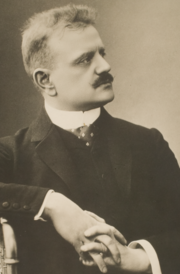Type a search term to find related articles by LIMS subject matter experts gathered from the most trusted and dynamic collaboration tools in the laboratory informatics industry.
| Kyllikki | |
|---|---|
| Piano solos by Jean Sibelius | |
 The composer (c. 1905) | |
| Opus | 41 |
| Composed | 1904 |
| Publisher | Breitkopf & Härtel (1906)[1] |
| Duration | 10.5 mins[2] |
| Movements | 3 |
Kyllikki (subtitled "Three Lyric Pieces"; in German: "Drei lyrische Stücke"),[3] Op. 41, is a three-movement suite for piano written in September 1904[1] by the Finnish composer Jean Sibelius. Although the title is taken from the Kalevala, Finland's national epic, Sibelius denied that the piece was programmatic in nature.[1] (Kyllikki is a maiden who appears in Runos XI–XII.)
In September 1904 found Sibelius beset by dual distractions. First, he worried that he was beginning to go deaf (as he wrote to his patron, Axel Carpelan, "My hearing is very bad ... As far as the new works I am working on are concerned, I rely on the inner ear ...") and he even admitted himself to a private clinic). Moreover, construction on Sibelius's new home in Järvenpää (subsequently named Ainola after his wife, Aino) was nearing completion and the family was preparing to move in at the end of the month.[4] Nevertheless, Sibelius was in a good mood ("I have sunny thoughts".) and experienced a creative surge: he had begun work two major projects, the Third Symphony (Op. 52, 1904–1907) and the incidental music to Pelléas et Mélisande (JS 147/Op. 46, 1904–1905) for a production at the Swedish Theatre of Maurice Maeterlinck's 1893 play. Moreover, around 22 September he finished work on a three-movement piano piece called Kyllikki.[4]
The work consists of three movements:
Musically, Robert Layton argues that Kyllikki "speaks much the same harmonic language as the Second Symphony and the Violin Concerto".[5] The Sibelius biographer Andrew Barnett, too, emphasizes the suite's "Kalevala romanticism"—indeed, the "end of a stylistic" in the composer's output for piano.[6]

Layton, however, dismisses Kyllikki as "on the whole ... an unsuccessful piece with few attractions ... the actual paint writing is, by the exhalted standards Sibelius himself set elsewhere, limited in resource".[7]
The American pianist David Rubenstein made the world premiere studio recording of Kyllikki in 1971 for the Musical Heritage Society.[1] The table below lists this and other commercially available recordings: